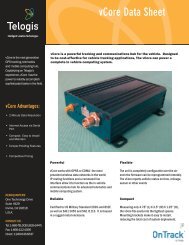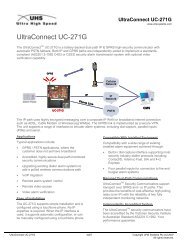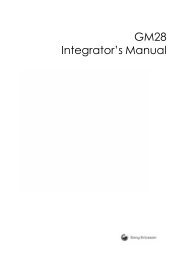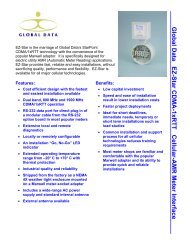Hardware Interface Description - KORE Telematics
Hardware Interface Description - KORE Telematics
Hardware Interface Description - KORE Telematics
Create successful ePaper yourself
Turn your PDF publications into a flip-book with our unique Google optimized e-Paper software.
XT55/56 <strong>Hardware</strong> <strong>Interface</strong> <strong>Description</strong><br />
Confidential / Released<br />
s<br />
The CYCLIC SLEEP modes give you greater flexibility regarding the wake-up procedures:<br />
For example, in all CYCLIC SLEEP modes, you can enter AT+CFUN=1 to permanently wake<br />
up the module. In modes CFUN=7 and 8, the GSM part of the XT55/56 automatically<br />
resumes power saving, after you have sent or received a short message or made a call.<br />
CFUN=5 and 6 do not offer this feature, and therefore, are only supported for compatibility<br />
with earlier releases. Please refer to Table 11 for a summary of all modes.<br />
The CYCLIC SLEEP mode is a dynamic process which alternatingly enables and disables<br />
the serial interface. By setting/resetting the GSM_CTS signal, the module indicates to the<br />
application whether or not the UART is active. The timing of GSM_CTS is described below.<br />
Both the application and the module must be configured to use hardware flow control<br />
(RTS/CTS handshake). The default setting of the GSM part of the XT55/56 is AT\Q0 (no flow<br />
control) which must be altered to AT\Q3. See [1] for details.<br />
Note: If both serial interfaces ASC0 and ASC1 are connected, both are synchronized. This<br />
means that SLEEP mode takes effect on both, no matter on which interface the AT<br />
command was issued. Although not explicitly stated, all explanations given in this<br />
chapter refer equally to ASC0 and ASC1, and accordingly to GSM_CTS0 and<br />
GSM_CTS1.<br />
3.6.4 CYCLIC SLEEP mode AT+CFUN=9<br />
Mode AT+CFUN=9 is similar to AT+CFUN=7 or 8, but provides two additional features:<br />
• GSM_RTS0 and GSM_RTS1 are not intended for flow control (as in modes<br />
AT+CFUN=5, 6, 7 or 8), but can be used to temporarily wake up the module. This way,<br />
the module can quickly wake up and resume power saving, regardless of the GSM_CTS<br />
timing controlled by the paging cycle.<br />
• The time the module stays active after GSM_RTS was asserted or after the last character<br />
was sent or received, can be configured individually using the command AT^SCFG.<br />
Default setting is 2 seconds like in AT+CFUN=7. The entire range is from 0.5 seconds to<br />
1 hour, selectable in tenths of seconds. For details see [1].<br />
3.6.5 Timing of the GSM_CTS signal in CYCLIC SLEEP modes<br />
The GSM_CTS signal is enabled in synchrony with the module’s paging cycle. It goes active<br />
low each time when the module starts listening to a paging message block from the base<br />
station. The timing of the paging cycle varies with the base station. The duration of a paging<br />
interval can be calculated from the following formula:<br />
4.615 ms (TDMA frame duration) * 51 (number of frames) * DRX value.<br />
DRX (Discontinuous Reception) is a value from 2 to 9, resulting in paging intervals from 0.47<br />
to 2.12 seconds. The DRX value of the base station is assigned by the network operator.<br />
Each listening period causes the GSM_CTS signal to go active low: If DRX is 2, the<br />
GSM_CTS signal is activated every 0.47 seconds, if DRX is 3, the GSM_CTS signal is<br />
activated every 0.71 seconds and if DRX is 9, the GSM_CTS signal is activated every 2.1<br />
seconds.<br />
The GSM_CTS signal is active low for 4.6 ms. This is followed by another 4.6 ms UART<br />
activity. If the start bit of a received character is detected within these 9.2 ms, GSM_CTS will<br />
XT55/56_hd_v02.06a Page 49 of 125 17.12.2004
















